|
Day 7 (31th December 2000) Sayun-Tarim-Sayun
Day 8 (1st January 2001) Sayun-Marib
Day 9 (2nd january 2001) Marib-Sana'a
On 30 December 2000
we settled ourselves at the Tower Hotel in Sayun. We planned to stay here for two days including New Years Eve. Our Hotel was fairly big and could host several big groups. Independent travellers like us are clearly
an exception. While we were there they provided shelter for two Italian groups. They probably had done the desert trip, most likely the one from Marib. White faces, hollow eyes and a dusty appearance, the
aftermath's of being bashed through the desert planes for several hours in a row.
Later that afternoon we decided to take a walk to the city centre. While we walked through the streets small groups of men
were already going towards the mosque for the evening prayers. The sight of us didn't surprise them at all, foreigners in the streets of Sayun seems to be a fairly normal thing. The city centre of Sayun is compact
with the Sultan's palace as the most impressive landmark. With it's white-bluegreen appearance of the building it is the jewel of Sayun.
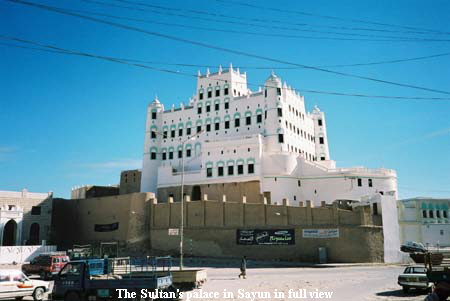 |
In front of the Palace a small market place provides the grounds for Sayun's trading centre.
Sitting on a stone wall in front of the Palace we watched people going by, doing their business.
 |
Later we did some shopping ourselves and ate a small square egg pizza overlooking the
street near the park of Sayun. On our walk back we had a bit of trouble finding our Hotel again. It was already dark and the streets empty, quite different from when we walked to the city.
Guided by our GPS we managed to walk into the right direction again and an hour later we found our Hotel again. After eating some bread, soup and coffee in our room we turned in
early thinking about the exhausting drive through the Wadi Hadramawt.
The next morning we left the Hotel round 9am. The big groups had already packed their stuff
and were long gone, trying to make their busy initiary. Ahmed drove us to the Sultan's Palace where we took our time to see the inside.
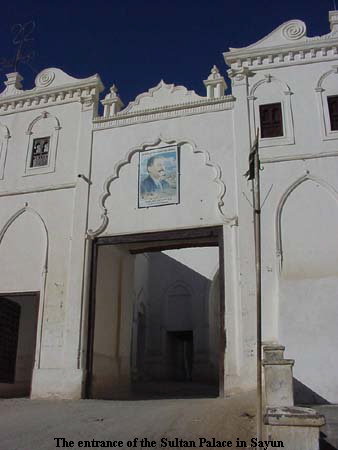 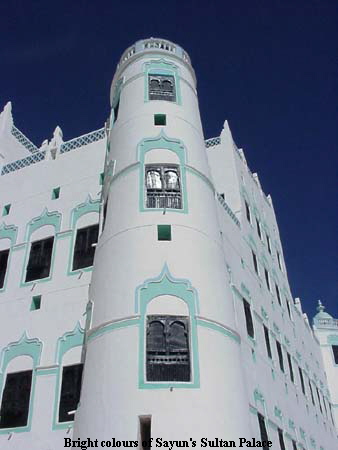
A quite impressive building with a small museum showing lots of western stuff from before
WW-II. The Sultan must have had quite a taste for these things. Pictures on the wall even showed one of the first cars in Yemen. We pondered our minds about what kind of trip that
must have been. Driving such a fragile car through the desert to Sayun, what a contrast.
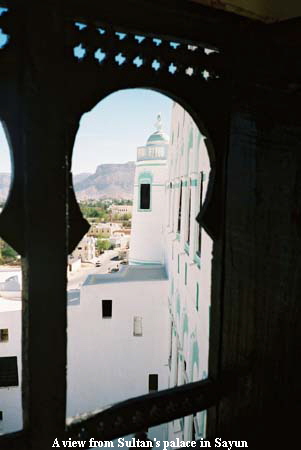 |
To our surprise a part of the museum also hosted a collection of black & white pictures from a
Dutch amateur photographer. The collection came from the Historic Museum in Amsterdam. The photographer was a diplomat who spend a lot of time in the Middle-East. Even more
surprising, many pictures showed sceneries which are still the same after all these years. The people, the faces, their clothes, just like the pictures had been taken yesterday. We left the
museum completely baffled; life we are experiencing now is just like it was then.
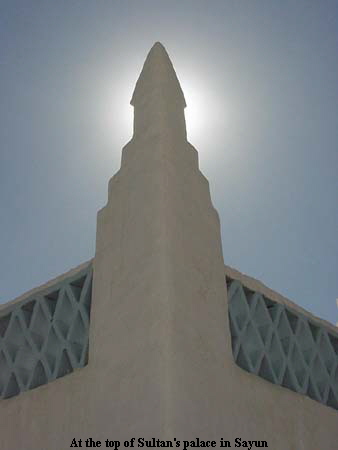 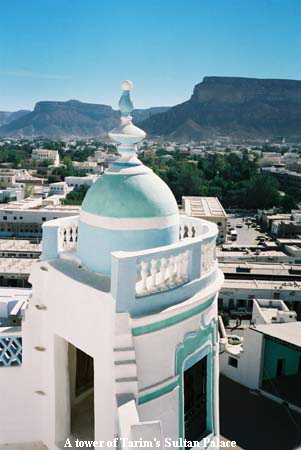
Next we visited Tarim, just a short drive from Sayun. Along the route we stopped shortly at a small and incredibly white mosk build on the slopes of the Wadi. The tomb of Ahmed ibn 'Isa
Al Muhajir, a spiritual leader in 10th century, is still an important pilgrimage destination. The insides of the tomb breathes it's spiritual significance. The body language of the people who
maintain the tomb made no doubt about that. They showed us the complex with compassion and enthusiasm.
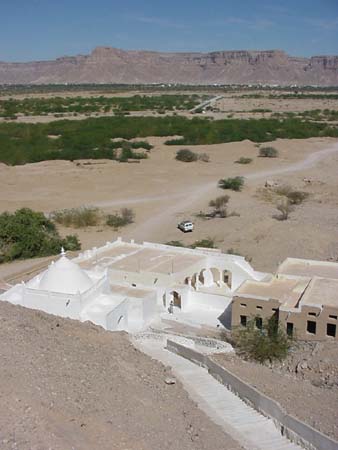 |
Near Tarim, we decided to walk into town, Ahmed would wait for us in the city centre. While
walking into Tarim we were stunned by the 'out of place' buildings we encounterd. Reading the history of the place, we learned about the Al-Kaf family. Their trading with Singapore
imported the 'Javanese Baroque' building style into Wadi Hadramawt. Build between the end of the 19th century and the 1930's, the houses dominate the appearance of Tarim.
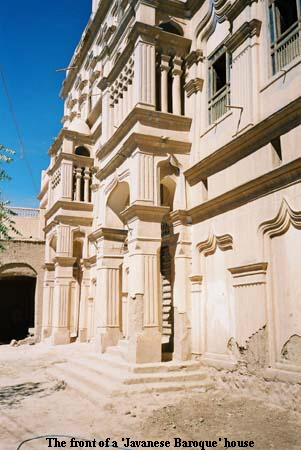 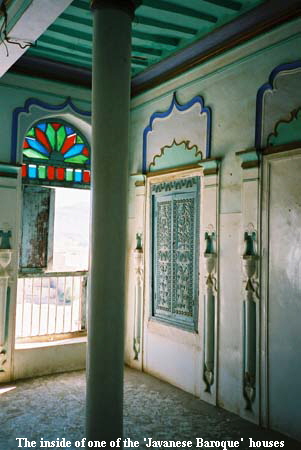
While we walked between these distinctive buildings we noticed that all of them were build from the same mud as used for Yemeni buildings.
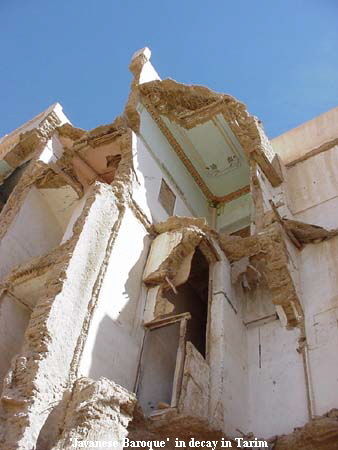 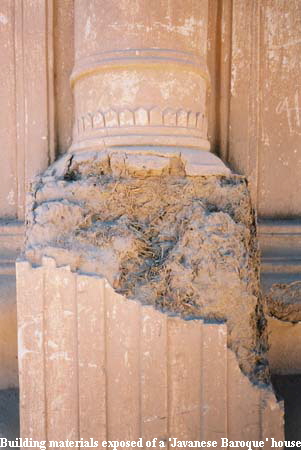
Several houses were converted into small museums, and we decided to visit one. The inside gave us a feeling like we had arrived in Asia, the building style so different from what we were
used to see in Yemen. The plumbing, the lighting and decorative stuff all breathed the style of the 1900's.
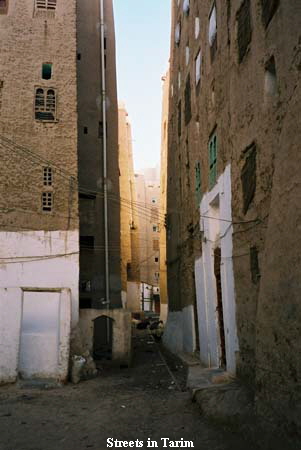 |
In Tarim city centre we found a small public library supported with funding from the Dutch
government. Inside we looked at several ancient Koran's and books some of them with some kind of mathematical drawings inside. Too bad for us none of the Yemeni people in the library
could follow our English :-) although the words they could pickup was a whole lot better than our understanding of classic Yemeni Arabic. When a large tourist group entered the library we quickly fled the scene.
Outside we were spotted by Ahmed, who had been walking through Tarim too. He caught us while looking at a man actually selling fresh fish!
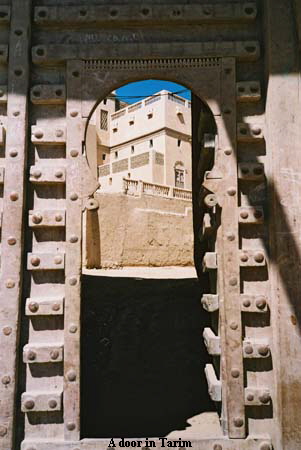 |
Walking back to Ahmed's car we decided to seek for a place to have lunch. On Ahmed's
questions if we wanted to try some camel meat, we couldn't say no. So off we went. Just outside Tarim we stopped at a small palm tree oasis where another Javanese Baroque
building was converted into a restaurant and Hotel. The place even had two swimming pools, one for the locals and one for the guests. Ofcourse the one for the guests was hidden behind
a big wall and trees. It's simply unimaginable to picture western men and women in their exposing bathing suits between Yemeni people. The wall around the pool looked like a good
idea to us too. But again we didn't feel like swimming so we just left the pool for what it was. And again we were lucky to get the chance to eat our lunch before the place got invaded by
another tour group. Although the camel meat wasn't that special, it was a tasty lunch.
Back at th Hotel in Sayun we suddenly realised that this was our first day without encountering
any military checkpoint. The south sure is managed different from the North of Yemen. Also people usually don't carry guns in this area, although we have no doubts about that the
weapon arsenal is probably huge over here too.
Later that afternoon we made a second walk through Sayun, this time to try and send some e
-mails and to get some bread. Finding the bakery wasn't quite that easy, in fact there isn't any bakery in the city centre. After being guided several times in the direction of the bakery we
simply couldn't find the place. In the end Janine just asked a pharmacist in his shop who quickly jumped in his car offering us to bring us to the bakery. A bit shaken by the sudden
offer, we stepped in and before we knew it we were jetted through Sayun. No way we could have find the bakery on our own. We bought several fresh loaves of bread in a small shack in
the outskirts of Sayun. With a big bag of bread we tried to walk back to our Hotel thanking the pharmacist for the ride. But well, that just wasn't it. He insisted to take us to our next
destination. To prevent things from getting complicated we just asked him to take us to his shop. From there we knew the way to our Hotel. On the way he couldn't resist telling us about
his fine leather jacket, which looked really neat indeed. Not sure he was offering us the jacket we managed to divert the conversation to where we wanted to get out. With a big smile he
stopped near his shop and we thanked him for the ride. "Good luck!" was his answer followed by "A happy new year". Hmmm we thought, we almost forgot! Tomorrow it's 2001, and we are
so into our daily routine of getting food, the change of the year is so incredibly far away.
Next we stepped into the Office of Yemenia, exploiting their Internet connection to tourists.
We quickly typed a few quick lines on the horrendous expensive connection, wishing everyone on the other side a "Happy new Year". Walking back to our Hotel we managed to
find our route back without problems.
Again we ate something in our room and updated our diaries till half way in the evening.
Determined to stay awake till the change of the year, we wandered a bit through the Hotel where two tourists groups got busy to prepare a party. With wine and champagne of course,
smuggled over the border in small bottles.
In the lobby of the Hotel we met Ahmed who was talking to a few other drivers. We discussed
the route for tomorrow again, knowing that Ahmed might think differently about taking the Asphalt route. The desert route still is the safest way, but the expensive Bedouin escort still
wasn't the thing we were waiting for.
Ahmed indicated that he had phoned the local police about taking the route, knowing that our
permit actually stated the Asphalt route. There was no problem they said, just go. A bit relieved we thanked Ahmed for bearing with us on this stretch of the tour. He knew well that if
Ahmed didn't want to take that route for whatever reason we just had no other option than to go along with it. But Ahmed still sighed a bit that he never had driven the asphalt route and
also neither any of the other drivers in the Hotel lobby did. Well, we thought than this is going to be a bit of an experiment. We knew that the route was fairly new and we suspected that
there either might be a lot of military there or a lot of Bedouin. At that moment we couldn't tell what was better, a combination didn't sound that good.
Just before 00:00 we gathered in the back yard of the Hotel. Around the swimming pool we waited for the change of the year and actually the real start of the new millennium. A really
strange setting, small groups of tourists and Yemeni people standing outside in the dark waiting for some awesome interesting event to take place. Actually we felt really tired and
most of all cold. We secretly hoped to get to bed quickly. Suddenly people started to countdown, even the locals joined in. Somehow we were ready to experience the outbursts of
millions of Kalasnikofs shooting into the air. But none of that, not one shot at all. Also no fireworks, just the sound of people wishing each other a happy new year in a strange setting.
We wished each other another happy millennium while standing at the pool side of a Hotel located in the south Yemen. It felt like an immensely unreal experience although we realised
that we were living a more real life like ever before. At the same time thoughts about our life at home felt downright artificial. Flashbacks of the fight for a bit of time and space at home
seemed so senseless. Traffic jams, stressed out faces in the supermarket, the anxiety of "not having" no matter what. What is it all about? Acquiring the infinite and ever lasting wealth
always hovering just behind the horizon? Or the state of actually not having to fight for time and space ever again, and just be? We don't know, but moments like these we treasure and
that alone might be (a part of) the answer.
A minute later we started looking for Ahmed. We found him standing in a group of other
Yemeni people watching their clients acting crazy with bottles of wine and champagne. We wished Ahmed and the other Yemeni people a happy new Year. Although we didn't know
whether they ever celebrated the event, we felt that they appreciated the gesture.
Later that night the Hotel staff had organised a local music and dancing group. We stayed for
more than a hour looking at the folklore although we had the impression that it was a bit commercialised. After that we decided to sleep in a horizontal position in stead of fighting sleep standing upright.
The next morning we left together with the other groups. In a long line of Landcruisers we drove towards Al Mukallah. At the junction to Marib we stopped at some roadside shop
where Ahmed bought fresh qat and a new supply of petrol. Today we had a stretch of 450 Km in front of us with the gnawing uncertainty that we might not make it to Marib without expensive Bedouin escorts.
The first 30 minutes of the route to Marib was quiet. No Bedouin or military awaiting us in an ambush or whatsoever. In fact there was no traffic at all, which was a bit of a contrast with the
road towards Al Mukallah.
Then the first checkpoint loomed in the distance. Coming closer we seemed to attract quite a bit of attention, every soldier stood up and watched at us coming closer. When we stopped a
lot of talking erupted, but then the presence of our permits silenced the talking somehow. A soldier quickly stepped into our car and off we went. A bit surprised by it all we continued our route towards Marib.
The desert started to dominate our surroundings, sand everywhere marked with tracks of cars virtually everywhere around us. Must be a busy place here, but somehow not at this time.
After 15 minutes another military checkpoint came into sight. Again the same happened and again another soldier stepped into our car and off we went.
We started wondering if this would continue for the rest of the day. At the third checkpoint after just about 45 minutes 'en route' we felt that this would be the day of the 1000
checkpoints. Again another soldier swapping ritual, permits being waved around and off we went.
Some of our guards were quite talkative and wanted to know virtually everything about us. It
seemed to us there wasn't that much traffic on this route and boredom must be a soldiers biggest enemy in this desert landscape. Only in the far distance we could determine vague
hills or mountains on both side of the road. Ahmed told us that he knew every landmark in the surrounding area, which he used many times for navigation through the desert.
At some point we came close to a few black hills and our guard indicated that a lot of smuggling went on here. Smugglers hide themselves behind the rocks and do their trading
with their colleagues from Saudi. We could only imagine what products might be in desperate want on the other side of the border. But not only products are crossing the border into Saudi.
People looking for a better life are prepared to make the same journey through the desert. It must be hard to blend in with the modern Saudi's after such a journey we thought.
A few times we spotted car, truck and tank wrecks besides the road. From the stories from several guards the cars and trucks were the sad results of drivers being tired. They keep
themselves awake with drivers qat, a very strong qat variant we've been told. Not always that successful it seems, many wrecks showed signs of a violent ending. Ahmed added that also
camels are frequent victims of the new road. They just aren't aware of the danger and walk across the road in front of onrushing cars.
The tanks are the tell tale signs of a different story. The war of unification was also fought in this part of Yemen. The leader of south Yemen seemed to have staged his last offensive in
this region, just before he sought shelter in Oman. Our guards told about it with great excitement as it just happened yesterday. We silently looked at the blacked out pits in the
sand with carcasses of tanks in the middle. A random drive or walk through the desert won't be that healthy we assumed, leftover's from the war might still be looming under the sand.
We passed several small villages, in most cases not more than 6-10 houses frying in the shivering heat of the desert. Of course each small village has it's own military checkpoint,
presumably giving it a reason to exist in this unearthly place. After passing a military airfield we reached the town of Al Abr. Situated close to the Saudi border, the town showed the signs
of an oncoming expansion wave. A lot of building activity was going besides the road. We started wondering what might people persuade to starting building a living in this region of
Yemen? A trading town with Saudi Arabia or new oil fields in the region about to be exploited? Ahmed couldn't tell either and our guard kept silent about this.
So far so good. We didn't encounter any problems up to this stage of the asphalt route towards Marib. But somehow we didn't feel that sure that luck would stick for the rest of the
day. A sudden encounter with Bedouin people asking questions what we are doing on their land without a Bedouin escort might trip a bit of a conflict.
The many military checkpoints in this region might also be a sign of a stand-off between the Yemeni government and the Bedouin. Also disputes with Saudi Arabia about the
undemarcated border in this area might clarify the dominant presence of the Army. Anyway, if we would have travelled here with our own transportation we probably had to deal with a
military or bedouin escort all the way. But we still have serious doubts if that would have been safer compared to the way we are travelling now.
After Al Abr we followed a southern course away from the Saudi border. Streaks of black smoke started to appear in the distant horizon. At first we couldn't tell if it was bad weather or
from a fire. Coming closer we saw the signs of a big factory, unmistakably an oil company pumping oil from the desert floor. We knew from the kidnappings of oil workers that the Marib
region has a lot of oil. Looking at the brand new oil installations, The Hunt Oil company is doing good business in the Marib region. We wondered whether the Bedouin people are
getting a cut from the profits. Our gut feeling told us they don't.
Slowly our surroundings started to show signs of life near the oil fields. Around lunch time we
reached the Marib region. Ahmed parked his car near a large oil depot where a few shops were located selling food to truck drivers. Ahmed left us to get some qat and sigs and we
confiscated a small table near a food stall for lunch.
During lunch we got a few heavily armed visitors, clearly Bedouin people curious about what
we were doing. They were armed with Kalasnikofs, knifes, beepers, cell phones and Toyota Landcruiser car keys and dressed in squeaky clean traditional clothes. They showed happy
faces and were obviously very eager to learn about us and what brought us here.
Carefully avoiding the subject from what direction we came from today we told a few things
about our trip through the Middle East. Our nationality seemed to impress them a bit and triggered the question what we thought about Yemen. Our answers luckily kept their attention
away from the fact that we might be coming from the desert. Finishing our lunch they asked us where we were going. "To Marib" we said. Luckily at that moment Ahmed appeared again
and we packed our things and drove off waving at the Bedouin group. They waved back, still showing happy faces.
10 minutes later Ahmed told us that he got a bit of trouble while we had lunch. He was asked
why he came from the desert without a Bedouin escort. Ahmed clever as he is, told them he didn't need an escort because he's a Bedouin himself. So why bother getting an escort!
Ahmed smiled and said they took that for granted. Anyway, to us it seemed we just escaped from quite a conflict. We also realised that we never would have managed to drive into the
desert coming from Marib. Groups of Bedouin are simply waiting outside Marib to make sure nobody escapes into the desert without their company.
Just outside Marib we tried to visited two archaeological sites. Too bad the terrain was fenced and closed. Ahmed told us that since a few years the sites were closed for the public
because of looters picking the sites clean. Looking at the holes in the fence work we could only guess that the looting was still going on. The site of Mahram Bilqis, presumably named
as "The Temple of Refuge", impressed us the most. A row of impressive square pillars sticking out from the desert floor made us wonder what more was hiding below the sand. It is
said that this place was a shelter for anyone who needed one, even for prosecuted criminals. Now being fenced with barb-wire the place itself needs shelter from the herds of tourists and looters.
While we drove into Marib we noticed a grim atmosphere. Maybe it was because of the stories we read about this area. This place presumably seems to be the number one
business zone for kidnappers, the place the Dutch embassy explicitly doesn't recommend going. Also the place where the Yemeni government seems to have no control at all. Looking
at the heavily armed tribesmen walking around in Marib we could guess why.
Near the city centre Ahmed approached a large building fenced by huge stone walls. "The
Hotel" Ahmed said. We looked around us and saw nothing resembling a Hotel. No signs, no cars, nothing. Suddenly a gate opened next to us and Ahmed drove inside some sort of a
garden. We had arrived at the Paradise Hotel of Marib. A place we wouldn't have found on our own for sure.
The concrete building looked as it had been build real fast in the early 80's and had suffered
from a long period of decay. The inside confirmed our perceptions. Furniture from the 70's, huge sofa's in teeth grinding orange and brown colours with the seating so low to the ground
you practically have to lay yourself down.
The reception manager quickly showed us around. A huge place, the biggest we've seen so
far. Wide hallways, low ceilings and a lot of light coming from the windows. A concept unknown to Yemeni builders. After having tried a few rooms we found one with a working
toilet and shower. Our room had a king-size double bed, the first so far in almost six months! To western standards that's the same as a wide one person bed. Looking outside we saw
the remains of a swimming pool topped of with a huge heap of sand. What a contrast! The houses around the Hotel, including a mosque, had a clear view on the pool. Western people
bathing in exposing swimsuits in sight of the Imam of the mosque probably may have caused a bit of a dispute. The heap of sand might have settled the dispute.
An hour before sunset we left the Hotel to see the famous dams of Marib. But well of course not without a guard from the local police station. A shy young man stepped into the car,
holding his Kalasnikof like a magic wand. Afraid of being turned into a frog we made a bit room, trying not to be touched by his magical black metal wand.
According to history the Marib area was quite prosperous, the dam provided water for a big agricultural industry in those days. But not only that. Marib, also known as the capital of Saba
was known well on the incense route. The place provided shade and water in the desert, and an opportunity for the people in Marib to collect tax. When the dam broke around 570, the
place vanished from history only to appear again under Egyptian rule in 1960, making Marib the base for their operations.
Arriving at the old dam, we were approached by kids trying to sell all kinds of archaeological stuff presumably dug up from the sand. From their persistence, business apparently wasn't going that well.
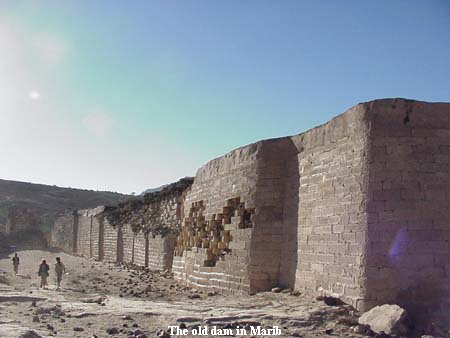 |
Everywhere we walked we had clouds of children drifting around us. The dam itself wasn't that
remarkable, although the way it was build attracted our attention several times. Several Sabaean and Himyarite inscription marked the wall and made us wonder what effort it must
haven taken to get these huge stones here in the middle of the desert.
Next we drove to the New dam, a project funded by Sheikh Zayed bin Sultan al Nahyan now
the ruler of Abu Dabi. His ancestors had lived near the dam, who after the disaster in 570 had migrated to the Persian Gulf. Turkish and Swiss people had build the dam in 1986, making it
a landmark in the area. Ahmed drove us to the top where we decided to walk over the dam to the other side. Our guard visibly got a bit nervous with this plan, which made us only wonder
why. On the other side of the dam we could see a small group of people. Other than that there was nobody around.
During our walk we noticed that the water level was quite low. In the distance we could see a
few small boats on the water, which made us wonder if there was fish living here. On the land side of the dam staircases were made every 50 meters making it possible to walk down to
the foot of the dam. Again our guard displayed strange behaviour, each time we passed a staircase he stopped and waited, while we just continued walking towards the other side.
Coming closer we could distinguish a big group of Bedouin sitting in the rays of the approaching sunset. Would be nice we thought to meet and talk a bit. But at the last staircase
down our guard started to point down, saying "please, please". His face displayed fear and anxiety. What was wrong we thought! We explained we didn't want to go down, but to the
group of Bedouin on the other side. Now our guard visibly started to sweat and he almost begged us to decend the dam. Judging he fears something terrible must be about to happen.
But to whom we thought. Are we at risk here? Or is it his own safety what's worrying him? After a short discussion we decided not to disrupt the feelings of our guard any further and
follow his route. Visibly relieved he quickly followed us down to the base of the dam. Ahmed was waiting already and we stepped in and fled the presumably hostile scene.
Further in the valley we drove towards the other end of the old dam, now landmarked with some sort of stone tower. While walking through the site, we found dam walls riddled with
bullets holes and the ground littered with shells. Somehow these signs of intense shooting looked real fresh as if it happend just an hour ago. On the hills above the dam we enjoyed a
good view over the valley and could clearly see the other end of the dam. In length the old dam must have been double the size of the new one. The flood which swapped away this
massive construction in 570 must have been really awesome.
We sat a while and looked at the sunset. Our guard visibly enjoyed the scene too, and in his
best English he told a few things about his life as a (tourist) policeman. We could imagine that he had lived through many hostile situations in this region where tribal uprisings are still a part
of daily reality. The arrival of the Hunt Oil Company must have caused a big change in this region. Oil now rules Marib in stead of the water from the dam. We visualised the Bedouin
tribes as a human dam trying to prevent a huge flood of oil spoiling the cultural heritage of the Marib region. The huge western demand for energy has already changed their life
considerably and probably will continue to do so in the future. The presence of large arsenals of automatic weapons might just be their last resort to get some grip on their own future.
Next we drove to old Marib, an almost uninhabited place ruined by several bombings raids during the war. Probably if it wasn't for the war, this place would still be the centre of Marib.
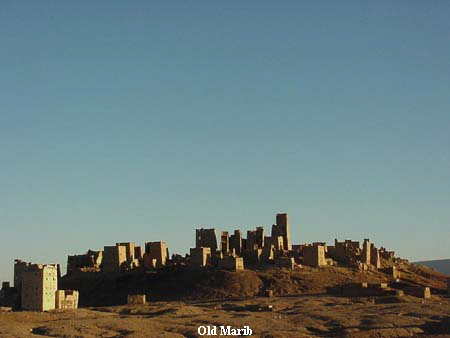 |
Just before old Marib we got company from a bunch of military in their Landcruiser. A huge
machine gun peered high from the cargo bay manned by a soldier ready to riddle anything with a curtain of bullets. We got an escort to the ruins as if we where a bunch of important suits on a sight seeing mission.
In the light of the sunset the mud brick ruins glowed like gold. On our walk through between the wrecked buildings we could see what materials were used to make these mud skyscrapers.
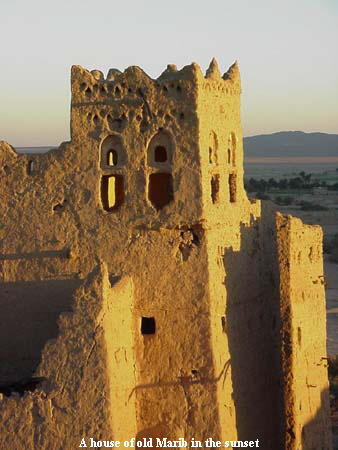 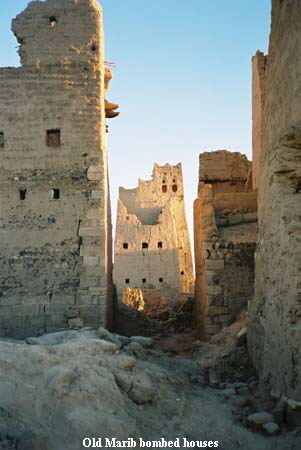
Essentially it's just wood, mud and straw what we saw. At one building our guard suggested
to climb the stairs to the top. Inside we walked up a mud staircase to the fourth floor. A bit uncertain if this building would still hold our joint weight we reached the 4th floor. Up there the
view was really nice, we could see the old and new dam including new Marib. In fact we stood on top of the heighest building of old Marib. In the distance we heard a bit of shooting,
growing in intensity rapidly. A strange atmosphere started to emerge quickly.
Standing in a bomb wrecked building we listened to the rattle of guns and watched a glowing
horizon while being escorted by an armed guard. Somehow it felt like we had arrived in the desert version of Beirut. The heavily army truck below us raced away towards the sound of
the shootings, which was in fact near the new dam. Was this what worried our guard during our walk over this damm? We couldn't tell.
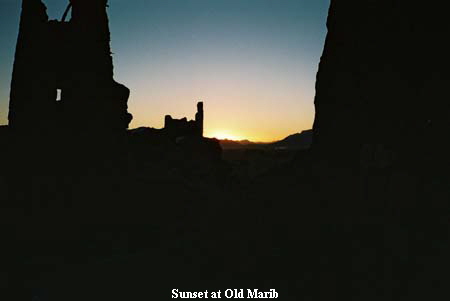 |
Down we decided it was time to go and Ahmed quickly raced us to new Marib. Just before
dark, the time we really should be getting inside, we asked Ahmed to stop in the centre to allow us to do some shopping. Our guard's face suddenly became really pale. While we
stepped out in a street in Marib, we noticed many curious eyes being pointed at us. Probably this wasn't a usual kind of thing to see, two foreigners shopping after sunset in Marib. In fact
at the call of prayer, a time where there isn't that much shopping to do. We quickly bought a few things with our guard literally breathing in our neck. Several times he made gestures to
start walking back to the car. Our gut feeling told us that we weren't that welcome here, although people didn't look that grim.
Back at the Hotel, we cooked dinner in our room again. We ate our last pack of soup with a fresh stack of Yemeni bread. Next a spicy vegetable salad with again Yemeni bread but now
plastered with a layer of peanut butter. Our dessert was simple, a lot of oranges with a cup of tea. Later we lit our DragonFly again for coffee with a bunch of cookies. A simple dinner
which we cooked in the bathroom :-)
Several times during our journey we suspected that our multi-fuel burner made too much
noise. At full blast it sounds like a powerfull blowtorch, making a normal conversation in the 'kitchen' quite difficult. Mixed with the fumes of cigarette lighter fuel, the smell of soup and
coffee we might have caused other guest to wonder what was happening next door.
After writing our diaries, logging GPS waypoints, our route and some reading we nearly
collapsed round 9pm. It was an exciting day, a lot has happened again. Although the landscape didn't change that much, we entered a region where the (economical) forces of
western society intersected with the interests of the Bedouin. The raging demand for energy in a different world has already caused many disputes in Marib and there will probably be
more to come. Maybe it's better to have no oil or any other profitable resource looming under the soil. At least there might be a fair chance to control what's happening to the region.
In short we passed a total of 18 checkpoints today, our personal record. At each checkpoint we watched a ritual of permits being waved, soldiers refreshed and a lot of excited talking.
But best of all, we experienced a day without 'checkpoint' bakshees. We got away without having to drop a penny. Also the army material we saw was quite new compared to the worn
out stuff we saw at the seaside of southern Yemen. Maybe the soldiers are simply being paid better and don't need tourists to make a living. Nonetheless, their dominating presence on
this route might have more to do with undemarcated border disputes with Saudi Arabia than trying to put a lit on Bedouin hostilities. And again this all might just be because of what's
looming under the desert floor.
On the 2nd of January 2001 we packed our bags again and left the Paradise Hotel of Marib
for the last leg of our journey. On the way out we were asked to help and push a Landcruiser of a group of Bedouin. 'Mush mush kila' (No Problem) we said. After several attempts the
huge diesel engine just wouldn't ignite. Desert sand and dirty diesel might have clogged the nozzles. Stepping into our car, we suddenly realised that this Landcruiser was our escort. And
with us two armed locals stepped into our car too. Darn! Have we trapped into an expensive Bedouin escort after all? Driving through Marib we feared the worst. But at the first checkpoint
outside Marib we noticed that we these people were local policemen. Ahmed smilingly said that the guy in charge at the Marib checkpoint asked the two men if they were going on a
holiday together. We smiled, this might just be the case.
After have driven a few hours we noticed the landscape change. Volcanic remains littered the
surroundings and we started to gain altitude again. We were approaching the Sana'a region. At a high mountain pass we stopped and watched the view over a desert of volcanic rock.
The soft light sand brown colour has changed into dark brown and black.
We wondered how this part of the world would have looked with active Vulcan's. Iceland deja
vue's rushed through our heads. A thing we never had suspected from Yemen was that some regions are quite similar to the volcanic scenery of Iceland.
At the checkpoint demarcating the Sana'a region Ahmed stepped out to buy some qat. With the rise in altitude fresh qat came within his reach again. This plant only grows on
considerable altitude. That's probably why qat isn't that popular in the southern region of Yemen. Too hot and too low in altitude.
As this day was the last of our journey we asked Ahmed to park his car a bit away from the road for a few pictures. At first Ahmed protested because he feared being shot at from the
houses in the distant. Too dangerous he said. But a bit further he agreed and got out posing in front of his car. We watched for possible snipers carefully and quickly shot a few pictures of Ahmed.
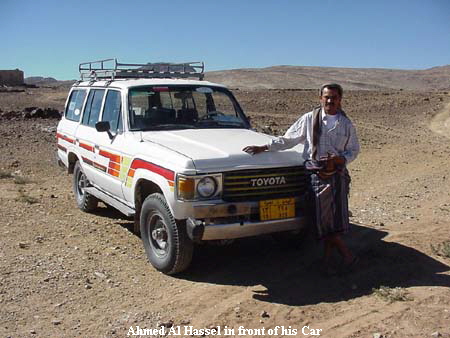 |
Although we didn't suspect to be at any kind of risk we could imagine Ahmed's fears.
Specially in the region where qat is grown, it's almost suicide to step into qat fields. Although being a (crazy) foreigner might just save us from a rain of bullets.
Round noon we reached the Sana'a checkpoint. A long randomly formed queue was waiting and we watched cars being checked real thoroughly. While waiting we looked at several
Kalasnikof shops. Many rows of fresh Kalasnikof's were on display and there might be some on sale too! What a chance we thought, may be we should get a bouquet as souvenirs for
family and friends. But again, getting them passed the Sana'a checkpoint might be a bit difficult. Possession and public display of firearms is forbidden in Sana'a as we noticed
earlier. We had already spotted many Yemeni men carrying Kalasnikof clips while wandering through the Sana'a city centre. Nah, just holding the clip wasn't the real thing, maybe later :-)
After the Sana'a checkpoint we headed to one of the major sights of the region around Sana'a. The Dar al-Hajar rock palace, a Yemeni house build on top of a rock.
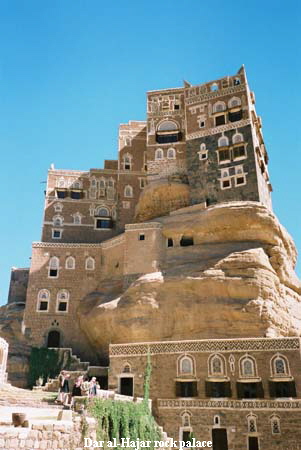 |
Many tour operators offer trips to this house and we braced ourselves for a tourist group flood
. But we got lucky, real lucky. We were the only foreigners round noon visiting the place. Inside the palace we noticed a lot of effort was put in there to make the place look real good.
It's partly a museum and also used for hosting VIP visits. The many black and white pictures
on the walls showed the various faces of Yemen. We recognised many locations we visited the past week. Even some of the people we met were posing in these pictures.
Halfway up in the palace we got company of a Yemeni family with two small children. A bit shy but quite confident we were asked to pose for a picture.
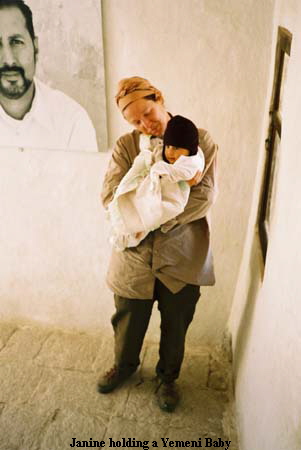 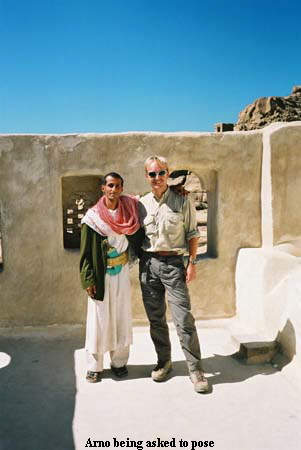
A few rooms further we attracted the attention of a guardian instantly giving us a personal tour through the rest of the palace. And of course we couldn't get away without first having to take a few pictures of him.
He told us that he didn't see independent foreign travellers that often which apparently triggered an avalanche of questions on his side.
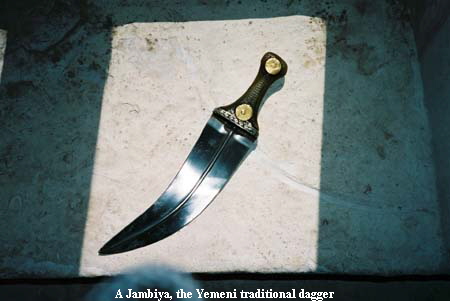 |
After thanking him for his extensive tour through the building, we wandered around the building for a bit.
The palace had impressed us, but not because of it's remarkable location and architectural style. The modesty and charm of the inside made the place stick out in our minds. A way
which, we feel, reflects the Yemeni society.
In the car again, we asked Ahmed to guide us to a good place to have lunch together, as our
treat. A place which he would choose when he was hungry. 30 minutes later we found ourselves in an incredibly busy place with our table fully packed with a variety of Yemeni food.
It was delicious although we could only eat half of it.
At some point a poor Yemeni man joined us on the other end of the table. He took a few
leaves of our heap of bread and mixed it with a small dish of the sallad he had ordered. A moment later the bread had vanished, including the full stack of bread. And before we could
say a word he was outside with carrying a huge bag, probably containing our bread. We smiled; good for him we thought. The first time in Yemen we had managed to eat all our bread!
Back at the Sultan Palace Hotel we thanked Ahmed for the tour, his excellent guiding and most of all as a worthy travel companion. After having travelled for nearly 5 months ourselves,
Ahmed knew exactly how to blend in with our way of travel. We considered the risk he took for us by driving the asphalt route between Sayun and Marib as a sign of his flexibility and
courage. And we knew he wasn't just doing something. He made several inquiries on his own to make sure we didn't got ourselves into an unacceptable mess on this route. Ahmed also
understood our situation, that we were different from the usual commercial package tourist. That we were travelling on a budget to make such a long trip possible and that we had more
flexibility in time than in finance. Since he was going to stay for a few days at the Hotel we promised to join him for a chat later on.
The past 3 days we've covered a stretch of 699 kilometre and passed a total of 26 checkpoints. We'd spend 10 hours on the road with an average speed of 70 Km/hr. Quite
high for Yemen, but mainly contributing to the big distance (466 Km) between Sayun and Marib on a reasonably good road.
In a 9 day trip through the south of Yemen we've learned a great deal about the country. The variety of landscapes, people, cultures and weather is simply overwhelming. The
geographical location of Yemen protected the country from many (western) influences and on the other hand prevented development in the area's where more progress (such as
medication) is required. Desert on one side and sea on the other side still isolates Yemen, but we think that will change in the (near) future. An asphalt road connection with Oman will
probably boost trade with the Gulf states which now depends heavily on air transportation. Undoubtfully the relation with Saudi Arabia will start to flourish again but slowly.
We feel Yemen is the pearl of the Middle-East with still many old customs and cultures in tact. Their classical Arabic language is just an example of this. We strongly hope their identity and
civilisation will prevail. From our point of view the western world can (still) learn a great deal from this country. After having spend months in the Middle-East we strongly experience our
Dutch society as a third world country from a social point of view. Specially in Yemen we've seen a tightly knit society long lost in our own world.
In our trip through the South of Yemen stretched a total distance of 1896 kilometres and 36 hours on the road. An average of 210 Km a day with 4 hours on the road.
|
|
